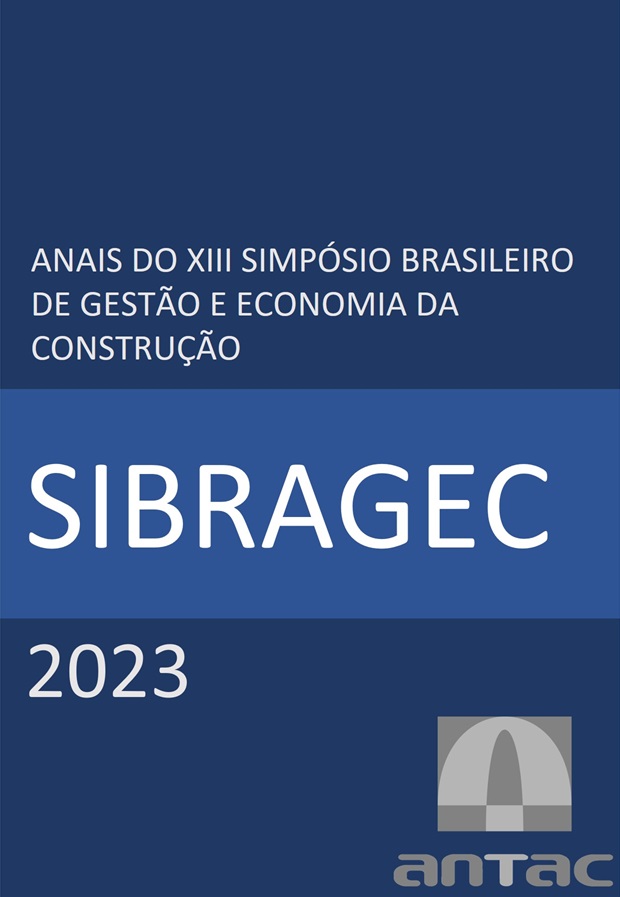Implementação de Last Planner em empreendimento industrial com locais e atividades não repetitivas
DOI:
https://doi.org/10.46421/sibragec.v13i00.2668Keywords:
Planejamento e controle da produção, Construção enxuta, Last Planner SystemAbstract
O Last Planner System (LPS) é um modelo de planejamento e controle da produção colaborativo e fundamentado nos princípios da filosofia da produção enxuta. Embora o LPS tenha sido extensivamente aplicado em empreendimentos com atividades repetitivas, sua implementação em empreendimentos com locais e atividades não repetitivas permanece pouco explorada. Este estudo contempla o primeiro ciclo de uma pesquisa-ação para implementação do LPS em um empreendimento industrial com locais e atividades não repetitivas. Os resultados sugerem que a implementação do LPS em empreendimentos dessa natureza apresenta desafios únicos que requerem consideração cuidadosa, incluindo a necessidade de maior flexibilidade, planejamento mais colaborativo e maior foco no compartilhamento de conhecimento entre os membros da equipe. No entanto, o estudo mostra que o LPS pode ser efetivamente implementado em empreendimentos com atividades não repetitivas promovendo um melhor planejamento. Os benefícios da implementação do LPS em empreendimentos com locais e atividades não repetitivas incluem maior colaboração da equipe, melhor comunicação e melhor sequenciamento de tarefas.
Downloads
References
BALLARD, H. G. The last planner system of production control. Birmingham, 2000. 192 f. Ph.D., University of Birmingham, Birmingham, 2000.
BALLARD, G.; TOMMELEIN, I. Current process benchmark for the Last Planner System. Lean Construction Journal, Berkeley, p. 57-89, 2016. Disponível em: http://lean-construction-gcs.storage.googleapis.com/wp-content/uploads/2022/08/08160555/LCJ_16_011.pdf
BERNARDES, M.M.S. Planejamento e Controle da Produção para Empresas de Construção Civil. 2ª edição. Rio de Janeiro: LTC. 2021.
COUGHLAN, P.; COGHLAN, D. Action research for operations management. International Journal of Operations & Production Management, v. 22, n. 2, p. 220-240. DOI: https://doi.org/10.1108/01443570210417515
DICK, B. You want to do an action research thesis. Interchange, v.6, 1992.
GONZÁLEZ, V.A.; OROZCO, F.; SENIOR, B.; INGLE, J.; FORCAEL, E.; ALARCÓN, L.F. LEBSCO: Lean-Based Simulation Game for Construction Management Classrooms. Journal of Professional Issues in Engineering Education and Practice. 2015, 141, 04015002. DOI: https://doi.org/10.1061/(ASCE)EI.1943-5541.0000243
LINNIK, M.; BERGHEDE, K.; BALLARD, G. An Experiment in Takt Time Planning Applied to Non-Repetitive Work. In: ANNUAL CONFERENCE OF INTERNATIONAL GROUP FOR LEAN CONSTRUCTION, 21., 2013. Proceedings [...]. Fortaleza: IGLC, 2013. p. 609-618. Disponível em: https://iglcstorage.blob.core.windows.net/papers/attachment-cc705c31-b276-4d8b-ab6d-a6f4757aa520.pdf
MIRON, L.I.G. et al. Jogos didáticos utilizados como instrumentos no ensino de Arquitetura e Gestão da Construção. Arqsur, n. 1, 2012. Disponível em: https://www.ufrgs.br/jogolinhadebalanco/linha-de-balanco/
OTTOSSON, S. Participation action research-: A key to improved knowledge of management, Technovation, v.23, n. 2, p. 87-94, ISSN 0166-4972, 2003. DOI: https://doi.org/10.1016/S0166-4972(01)00097-9
RAPOPORT, R. N. Three Dilemmas in Action Research: With Special Reference to the Tavistock Experience. Human Relations, 23(6), 499–513, 1970. DOI: https://doi.org/10.1177/001872677002300601
THIOLLENT, M. Metodologia da pesquisa-ação. São Paulo: Cortez. 2000.
TOMMELEIN, I. D. Collaborative Takt Time Planning of Non-Repetitive Work. In: ANNUAL CONFERENCE OF INTERNATIONAL GROUP FOR LEAN CONSTRUCTION, 25., 2017. Proceedings [...]. Heraklion: IGLC, 2017. p. 745-752. DOI: https://doi.org/10.24928/2017/0271
VALENTE, C. P.; MONTENEGRO, G. A.; BRITO, F. L.; BIOTTO, C. N.; MOTA, B. P. Guidelines for Developing a Line of Balance for Non-Repetitive Areas (Common Areas) at a Vertical Residental Building. In: ANNUAL CONFERENCE OF INTERNATIONAL GROUP FOR LEAN CONSTRUCTION, 22., 2014. Proceedings [...]. Oslo: IGLC, 2014. p. 763-774. Disponível em: https://iglcstorage.blob.core.windows.net/papers/attachment-56c426c9-8890-4812-a2f6-d3d8ea942360.pdf
Downloads
Published
How to Cite
Issue
Section
License
Copyright (c) 2023 SIMPÓSIO BRASILEIRO DE GESTÃO E ECONOMIA DA CONSTRUÇÃO

This work is licensed under a Creative Commons Attribution 4.0 International License.

